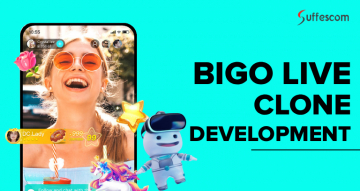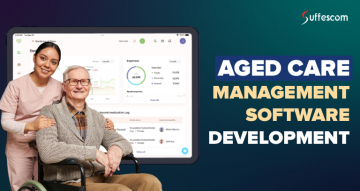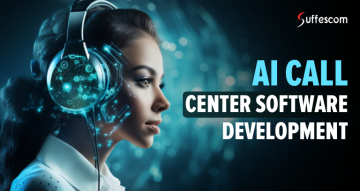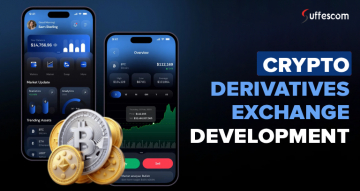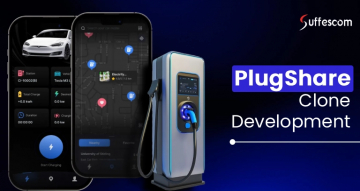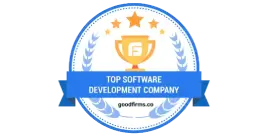Visual Inspection Software Development: Features, Cost & Use Cases
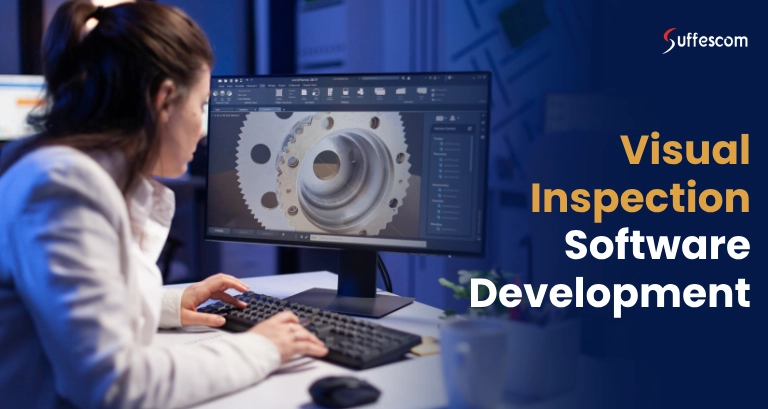
With the ever-changing industrial environment today, the importance of quality assurance and defect detection cannot be overstated when it comes to maintaining quality and reducing costs. Visual inspection software development has become a game-changer that enables businesses to automate the inspection process using advanced image processing and image analysis. This software can assist organizations in detecting defects, discrepancies, and irregularities in products with speed, precision, and scalability that manual inspection simply can't provide.
Integrating machine learning, computer vision, and deep learning techniques, AI-based visual inspection software is fundamentally changing this field. By utilizing smart systems that learn from large datasets to identify even very minor defects and patterns that traditional algorithms might miss. AI-driven solutions and systems can improve their reliability and accuracy continually; learning from defect examples helps reduce false positives over time.
How Does Visual Inspection Software Resolve the Business Problem?
Create AI-powered visual inspection software that helps businesses analyze key details and detect defects that can be missed with the naked eye.
1. Eliminates Human Error
The automated visual inspection system provides flawless results each time without any form of inconsistency or fatigue.
2. Defect Detection
Uses computer vision algorithms to assess products on assembly lines in real time. It helps reduce human error and standardizes quality assurance, thereby reducing returns and compliance issues.
3. Cost Reductions
The automated visual tasks reduce dependence on manual workers, which reduces inspection time and therefore leads to cost reductions.
4. Predictive Maintenance
Recognizes deviations and visual trends for evaluating machinery age. The software uses predictive analytics to find the abnormalities beforehand and fix them, saving time in the future.
5. Inventory Management
Uses object recognition and scanning barcodes/QR codes for tracking items in warehouses.
The visual inspection software enhances supply chain visibility to minimize loss while improving stock accuracy.
6. Enhancing Customer Experience
Uses facial recognition and emotion detection to evaluate client behaviors. The visual inspection system enables data-driven marketing and a personalized in-store experience.
Get Started with AI-powered Visual Inspection Software Today!
Visual Inspection Software Development Solutions We Provide
1. White Label Visual Inspection Software
Our white label solution provides businesses with a ready-to-use software platform that can be easily customized to meet their specific needs, eliminating the need for full-scale custom development.
3. Custom Visual Inspection Software
Leverage our custom software development services and build a platform loaded with unique features and design right from scratch. Perform modifications related to AI/ML model training and integration as per project requirements.
3. MVP Visual Inspection Software
Our MVP app and software services have helped various startups and enterprises achieve their dream software with essential features, all while keeping development fast and cost-efficient.
How to Build Visual Inspection Software?
1. Conceptualization
Start by defining inspection objectives clearly, like what defects need to be detected, under what context, and under what visual conditions. Requirements should also contain performance requirements, such as detection accuracy, false positive rates, throughput time, and permissible variability for the environment.
2. Model Development
Select or prototype a computer-vision pipeline: this may use classical image processing or train deep‑learning models like convolutional neural networks for object detection or classification. Develop initial prototypes, experiment with architectures, and assess early performance.
3. Evaluation & Validation
Evaluate detection performance using validation and test sets. Compare live captures against baselines. Measure key metrics like precision, recall, accuracy, and processing speed. If differences appear, categorize them and ensure that they are caused by genuine defects or environmental changes.
4. Right Tech Stacks Selection
| Aspects | Tech stacks | Description |
| Frontend Frameworks | React, Vue.js | Builds interactive user interfaces |
| Code Generation | GitHub Copilot | Suggesting code snippets & supports multiple IDEs |
| Backend Frameworks | Node.js, Django | Builds scalable server-side applications |
| Database | AWS, Azure | Offers infrastructure, storage, and AI services |
| Voice Interaction | GPT-4o Advanced Voice Mode | Facilities hands-free control |
| Database | PostgreSQL, MongoDB | Provides robustness and support for complex queries. |
| Cloud Platforms | AWS, Azure | Deploy and scale applications. |
| DevOps Tools | Docker, Kubernetes | Ensures consistency and scaling capabilities. |
| Security | Prometheus, Grafana | Collects, stores, and analyzes metrics |
| Visual Development | DALL·E, Firefly | Creates visuals from texts and offers AI-powered tools to generate layouts and graphics. |
5. Deployment & Integration
This stage involves the deployment of the visual inspection software to the production with all the necessary integrations in place to get actionable output.
6. Continuous Monitoring
Log, monitor, and evaluate system performance in production. Track detection accuracy, the incidence of false alarms, and the elapsed time needed to process the detection. When the performance of a model declines over time or new defects are uncovered, the model is fine-tuned using data annotation.
Visual Inspection System Development: Top Features Enhancing Accessibility
1. Defect Detection
The software utilizes advanced image processing and machine learning algorithms to analyze images and video feeds of products captured in static or dynamic conditions. The imperfections are identified, such as cracks, scratches, missing parts, or incorrect assembly, with little human activity to minimize human error.
2. High Resolution Image Capture
Visual inspection software uses high-resolution cameras to take images of the product being inspected. The visual inspection system captures inspection images, processes them in real-time or batch mode using various advanced techniques, including edge detection, pattern matching, and recognition.
3. Live Monitoring
Permits proper inspection and fetches real-time feedback while products are still in the manufacturing queue. In case a defect is detected, the visual inspection system alerts the personnel to stop production, preventing the continuation of defective products.
4. Data Reporting
Visual inspection software has dashboards and reports as part of its functionality. It gives awareness of defect types, frequency, and trends based on the inspection. All this is useful information, as, in business, you want to make decisions based on informed data.
5. Interoperability
The visual inspection software can integrate seamlessly with existing systems, such as ERP and MES. This helps with the systematic workflows in case of sorting and packaging, helping the businesses to be a part of the automated production environment.
6. Diverse Inspection Types support
The visual inspection system offers multiple inspection modes, ranging from surface defect detection to dimensional measurement, presence/absence inspection, and barcode/label verification. This provides all-in-one functionality, increasing the overall return on investment.
Visual Inspection Software Development: Real-World Use Cases Across Industries
1. Manufacturing
Visual inspection software development for manufacturing automates many processes in quality control. When products pass through production lines, when visual inspection software is used, defects such as scratches, cracks, or missing parts are detected before items are packaged to assure consistency of results and minimize human error.
2. Pharmaceuticals
Visual inspection software in pharmaceutical companies confirms that packaging is closed properly, all labels are applied, and ensures that all relevant information is provided with the packaging. This reduces the risk of errors made in packaging that can cause public safety problems and compliance challenges.
3. Electronics
Visual inspection software development for electronics detects small components to check that each part is in the right location and rotation on printed circuit boards (PCBs). The software for hardware electronics also inspects solder joint quality to prevent electrical failures.
4. Agriculture
The software for agriculture visually inspects the quality of fruits, vegetables, and other heavy produce items by detecting bruising, variance in size in relation to other like products, or ripeness levels. The software provides farmers and distributors with an accurate measure so they can grade their items and expedite sorting and packing.
5. Logistics
Visual inspection software in logistics to confirm the accuracy of barcodes and shipping labels on boxes/packages. This helps prevent errors in delivery. It can also determine the integrity of a package. Additionally, it can confirm the correct stacking. This is especially useful for speeding up warehouse operations and misshipments.
Accelerate Your Business Growth with Custom AI-Powered Visual Inspection Software Development
Why Are Businesses Keen On Investing In Visual Inspection System Development?
The automatic visual inspection system market size is expected to grow to $29.77 billion by 2029 with a CAGR of 11.8%. Businesses are excited about investing in visual inspection software development for various reasons:
1. Increased Quality Assurance: Visual inspection software automates and enhances quality assurance, resulting in greater accuracy in defect and anomaly detection and improved detection reliability compared to manual inspection.
2. Cost Savings: The automated manual inspections save a massive amount of money compared to conventional methods, without the risk of human error.
Efficiency: Accelerating production and inspection processes will lead to decreased turnaround times, increased productivity, and improved utilization of existing resources.
3. Scalability: Increasing production volume is no problem for visual inspection software, and you don't have to onboard personnel for inspection.
4. Data Driven Decisions: Real-time data provides means for actionable insights. Businesses can make product quality decisions with appropriate consideration, assess production lines, and make resource allocations.
5. Competitive advantage: Businesses that use advanced software such as AI-based visual inspection systems will establish a market lead and lead to greater customer confidence.
6. Integration in IoT and Automation: Visual inspection software integrated with IoT sensors and automated robotics, providing an increasingly innovative industrial ecosystem.
7. Regulatory Compliance: Demonstration of ongoing compliance by conducting industry-specific standards and or regulations consistently with ongoing levels of quality and performance evaluation.
Future Trends of Visual Inspection Software Development
The rapid progression of artificial intelligence is taking interesting turns and will undoubtedly transform visual inspection software. From rudimentary rule-based systems to innovative, adaptable inspection tools, AI-based visual inspection software enables machines to detect, classify, and even make defect predictions with human-level accuracy or better across various industry sectors.
Deep learning models and algorithms utilize convolutional neural networks, making it possible for AI-based visual inspection systems to create millions of labelled images to use as training data. As the quality of the training data improves, the model's performance, accuracy, and robustness will also improve, to the degree that even complex or subtle defects become detectable.
Edge AI has also emerged as a popular technology that has the ability to analyze and process visual data directly on the camera or embedded system. This allows for real-time, low-latency inspection or apprentice experience procedures which do not rely on cloud-based infrastructures. This is an invaluable tool for high-output production lines where every millisecond of production counts.
Furthermore, the next generation of AI-powered visual inspection software tends to utilize predictive analytics capabilities for specific manufacturing scenarios where there are reliability risks of breakdown or failure, and leverages data from those occurrences to anticipate breakdowns or maintenance needs.
How Much Does it Cost to Build AI-powered Visual Inspection Software?
The cost to create AI-powered visual inspection software ranges from $10,000 to $30,000, depending on numerous factors. Below, we have mentioned the key factors affecting AI development cost.
- Data Collection & Annotation.
- Model Complexity
- Hardware Integration
- Real-Time Processing Needs
- Custom UI & Reporting
- Industry Compliance
- Ongoing Maintenance
Visual Inspection System Development Company - The Difference We Deliver!
Suffescom is a reliable name in the industry, offering innovative solutions to businesses globally.
The agile development process, ongoing support, proven experience, helps with reduced costs and optimized production, thereby meeting the highest standards.
As a leading AI Development company, we have helped businesses with AI-powered visual inspection software driven by innovative features. We are committed to delivering work that sets us apart, developing marketing solutions that accelerate success by fostering long-term relationships with our clients.
Want to outnumber others in the market? Get in touch with us and let us turn your hurdles into scalable solutions that propel your business to remarkable growth!
Your Questions Answered!
1. How to Automate Visual Inspection with Computer Vision?
The in-built camera captures product images, and the computer vision algorithm detects potential defects. Further, the image is processed within an AI algorithm where visual data is processed and analyzed in real-time.
2. How To Build a Visual Inspection System with Computer Vision?
Define the visual inspection criteria, identify the appropriate cameras, integrate computer vision algorithms, train the computer vision system and deploy the system on the production line.
3. How much time does it take to build AI powered visual inspection software?
The development time ranges from 4-5 weeks, depending on the project requirements. The time may increase with the involvement of complexities.
4. Is AI used in advanced visual inspection systems?
Yes, AI-powered visual inspection software enables the defect detection, learn from new data and adapts to variations in product appearance.
5. What are the benefits of using a Visual Inspection System?
Early defect detection, higher inspection accuracy, reduced labor costs, and real-time monitoring are the prime benefits of using the software.
6. How is data stored on the visual inspection system?
The data is stored locally, either on edge devices or directly sent to cloud platforms, depending on system architecture.
